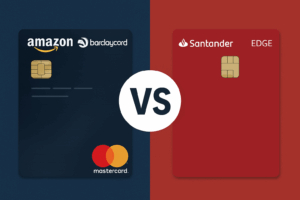
If you’re looking to compare UK credit cards to find one that rewards your spending, two excellent choices are the Amazon Barclaycard and the Santander Edge Credit Card. Both earn cashback or rewards, but they differ in structure, fees, and ideal use-cases. In this showdown, we cover key benefits, major downsides, when to use each card, and ultimately help you decide which card could be best for you.
Overview & Key Features
Amazon Barclaycard
- Earn rewards on Amazon.co.uk purchases, redeemable as points towards future orders.
- Also earns rewards on everyday spending (e.g., groceries and dining), though the highest value is typically realised within the Amazon ecosystem.
- Occasional exclusive Amazon offers, promotions, and bonus points for cardholders.
- Security features such as fraud monitoring and secure transactions.
- Standard APR applies if you carry a balance; paying in full avoids interest charges.
Trade-offs / Things to watch:
- Best for regular Amazon shoppers; if you rarely use Amazon, the value may be limited.
- Interest charges can erode rewards if you do not clear your balance monthly.
Santander Edge Credit Card
- 1% cashback on everyday categories such as supermarkets, fuel, and travel.
- No foreign transaction fees on purchases made overseas.
- Real-time management in the Santander mobile app (spend alerts, card freeze, account controls).
- £3 monthly fee (i.e., £36 per year) that should be weighed against your expected cashback.
- Cashback is capped at £15 per month.
- Fast online application; typical decisions in minutes and card delivery in 5–7 working days.
Trade-offs / Things to watch:
- If your spending is low, the monthly fee can outweigh the cashback earned.
- The £15/month cap reduces total earnings for high spenders.
- At 1% cashback, value is modest unless you use the card regularly in eligible categories.
Rewards Structure: A Closer Look
| Feature | Amazon Barclaycard | Santander Edge |
|---|---|---|
| Primary focus | Amazon purchases plus general everyday spending | Everyday categories (supermarkets, fuel, travel) |
| Cashback / points | Variable; best value when redeemed within Amazon | 1% cashback on eligible categories |
| Monthly/annual fee | No specific monthly fee highlighted | £3/month (£36/year) |
| Cashback cap | No explicit cap stated on points; value tied to Amazon redemption | £15 per month |
| Foreign transaction fees | Standard foreign/transaction fees may apply | No foreign transaction fees |
| Controls & app features | Standard protection and monitoring | App controls, card lock, real-time alerts |
| Ideal user | Frequent Amazon shopper | Everyday spender at home and abroad |
Analysis: If your spending is particularly Amazon-heavy, the Amazon Barclaycard’s integrated rewards can be compelling. If you travel or spend overseas and use your card for everyday purchases, Santander Edge’s fee-free foreign spending and flat 1% cashback make it a balanced option for many people.
Net Returns: Fees & Caps Matter
- At £3 per month, Santander Edge costs £36 per year. To break even, you must earn at least £36 in cashback annually — i.e., spend roughly £3,600 per year in eligible categories at 1%.
- Because cashback is capped at £15/month, the maximum annual cashback is £180 (15 × 12).
- For Amazon Barclaycard, consider the “opportunity cost”: the value is strongest if you redeem within Amazon and actively use the points you earn.
If your eligible spend is low to moderate and you’re not a frequent Amazon shopper, Santander Edge may not justify its fee. However, if you are a medium to high spender in its categories (up to the cap), it can offset the fee and still provide meaningful value.
Use-Case Scenarios — Where Each Card Excels
A) You’re an Amazon-heavy shopper
If most of your online purchases are through Amazon.co.uk, the Barclaycard’s Amazon-centric rewards — plus occasional promotions and bonus points — can add up quickly.
B) You travel or frequently buy outside the UK
Santander Edge’s no foreign transaction fees make it attractive for overseas spending, avoiding the typical 2–3% surcharge many cards impose.
C) Your everyday spend is substantial
For sizeable outlays on supermarkets, fuel, and travel (while staying within the monthly cap), Santander Edge can be competitive — especially if your cashback comfortably covers the monthly fee.
D) You prefer “set and forget” simplicity
Both cards are straightforward, but Santander Edge requires awareness of the monthly cap and fee. Amazon Barclaycard is more “hands-off” aside from leveraging Amazon offers and redeeming points effectively.
Pros & Cons Summary
Amazon Barclaycard
Pros
- Great for frequent Amazon shoppers with built-in, easy-to-redeem rewards.
- Earns on general spending as well, not just Amazon.
- Trusted security features from Barclaycard.
Cons
- Best value tied to the Amazon ecosystem.
- Rewards can be offset by interest if balances are carried.
- Less suitable for regular overseas spenders due to potential foreign fees.
Santander Edge Credit Card
Pros
- 1% cashback in everyday categories (supermarkets, fuel, travel).
- No foreign transaction fees — strong for travel and online international purchases.
- Excellent mobile-app controls and spend alerts.
- Predictable, simple cashback structure.
Cons
- £3/month fee can outweigh rewards for light users.
- Cashback capped at £15/month limits total earnings for high spenders.
- If you spend little in eligible categories, returns may be modest.
Final Verdict
Your best choice depends on spending patterns and priorities:
- Choose Amazon Barclaycard if you already make the majority of your purchases on Amazon and want integrated rewards that you’ll actively redeem.
- Choose Santander Edge if you spend broadly in everyday categories and/or travel abroad, and your monthly cashback comfortably exceeds the £3 fee.
For moderate spenders who aren’t heavy Amazon users or frequent travellers, run the numbers first: will your annual cashback under Santander Edge exceed £36? If yes, Edge can be a smart, well-rounded choice; if not, the Amazon Barclaycard may provide simpler value with fewer moving parts.

